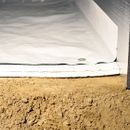Crawl space insulation on the bare ground when encapsulating–yes or no?
I have a 28×44 single story home located in the R-7 climate zone in northern Michigan. It has a closed crawl space with R-15 XPS foam board insulation affixed to the interior on the concrete block walls, taped and sealed for air tightness. All the rim joists are air sealed with XPS foam board and canned spray foam. Plumbing penetrations in sub floor have been sealed as well. House has electric radiant baseboard heat so there is no duct work in the crawl space. The floor in the crawl space is just dirt and is currently covered with a 6 mill vapor barrier. I’m thinking of having a thicker vapor barrier installed by one of the crawl space encapsulation companies. I have read a lot about crawl space insulation on the Internet, and I don’t see much info about placing some type of rigid insulation (Rockwool Comfortboard or XPS, on the bare dirt floor first, then sealing over that with the vapor barrier. It would seem like have insulation covering the dirt floor (earth) would make a great thermal break between the cold temps of the earth and the crawl space and make for a more efficient and comfortable crawl space? For example, Rockwool recommends placing their Comfortboard insulation on the bare earth floor and sealing with a vapor barrier prior to pouring a concrete floor in a basement to create a thermal break. So why is this same principal not recommended more with crawl space encapsulations? Is there a reason it would be bad to try and insulate the bare earth in a crawl space creating a thermal break prior to encapsulating? There is one encapsulation company that offers a product called TerraBlock which is a flexible 3/4″ waterproof foam insulation that can be rolled out on the crawl space floor then the vapor barrier is installed over it to encapsulate the crawl space. They don’t list what the R value it is however. Most crawl space encapsulation info simply recommends covering the floor with the vapor barrier and not insulation.
GBA Detail Library
A collection of one thousand construction details organized by climate and house part










Replies
Doing this would be similar to putting in subslab insulation under a concrete slab floor. It's certainly doable, but not commonly done. Crawl spaces usually insulate only the walls, sometimes also a "skirt" coming in along the ground from the walls maybe 4 feet or so. The earth further in tends to stay warmer (although typically under 50*F or so), so the benefits to insulating it are not as much as for insulating the upper part of the foundation wall that sees much colder temperatures.
The biggest issue putting foam down on the floor of the crawlspace is that you won't be able to easily access the crawlspace anymore for work without damaging the foam. If you want to put down rigid foam insulation (and I wouldn't bother with Comfortboard here, since it is much more expensive and doesn't really gain you much in this application), I would either put a thin "rat slab" of concrete over the top of it, or put down some plywood or OSB as a subfloor. Any of these materials will serve to protect the rigid insulation if/when anyone needs to get into the crawl space to do any maintenance or repair work.
BTW, I would recommend AT LEAST a 10 mil vapor barrier on dirt floor in a crawl space. I used 20 mil in my own crawlspace, since it's much more resistant to tearing when I go in there to work on anything (there is plumbing, ductwork, and electrical in there).
Bill
Thanks Bill! Very helpful info.
I just went through the same with my inspector who was being super nice to hear me out.
I was sitting in my crawl space working on the walls and my tush was cold even though I was within the code depths.
One thing my inspector did not allow was the idea of a floating thermal barrier 3/4 wood floor over the buried EPS was BECAUSE a floating floor isn't part of a test assembly for fire code. He was very specific that everything has to be tied down.
I asked if Rockwool could go over the board at 1.5" Comfortboard. Worked for him.